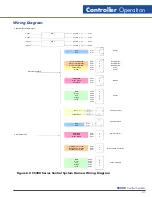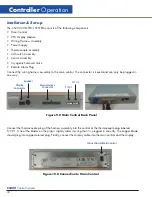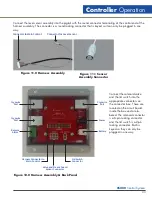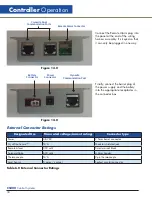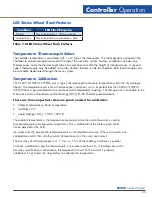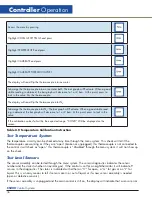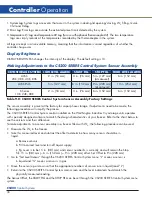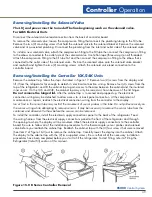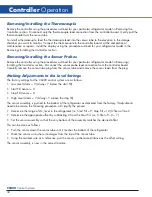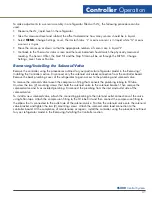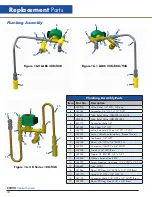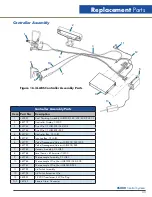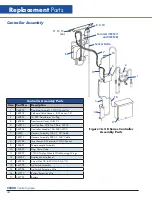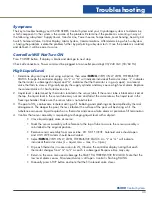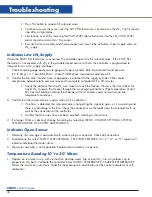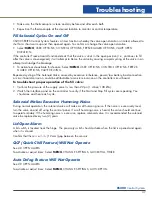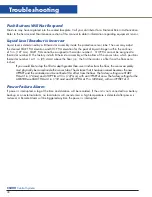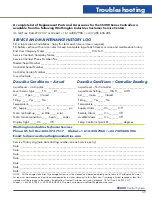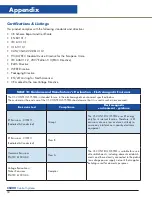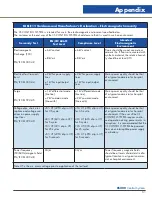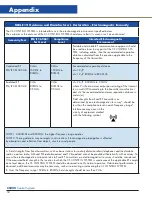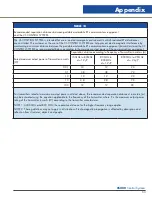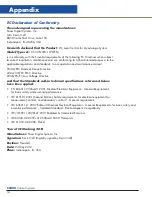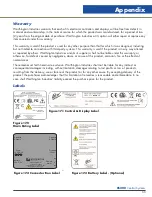
45
CS200
Control Systems
Troubleshooting
Symptoms
The key to troubleshooting your CS200 SERIES Control System and your Cryostorage system is to determine
which component in the system is the source of the problem. Determine if the problem is occurring in any of
the following subsystems: Supply Vessel, Transfer Line, Power Source, Temperature, Level Sensing, Security, Lid
Switch, Solenoid Valve, Control Display, Alarm System, Communications. After determining which subsystem
is having the problem, isolate the problem further by performing subsystem tests. Once the problem is isolated
and defined, it will be easier to solve.
Controller Will Not Turn ON
Press POWER button. If display is blank and dark go to next step.
Check all connections. Power cord must be plugged into an outlet providing100/240 VAC (50/60 Hz).
High Liquid Level
1. Determine physical liquid level using a dipstick, then select
MENU
, VIEW ONLY, LEVEL, THERMISTOR
STATUS through the controller display. An “L” or “G” will indicate individual thermistor status. “L” indicates
the thermistor is submerged in liquid and “G” indicates that the thermistor is in gas (vapor). A solenoid
valve that fails to close will typically empty the supply cylinder and may cause a high level alarm. Replace
the solenoid valve if it has failed even once.
2. Liquid level is determined by thermistors located in the sensor tube. If the sensor tube is blocked or iced at
the top, the liquid level in the sensor tube may not rise and fall at the same rate as the liquid level in the
freezing chamber. Make sure the sensor tube is not obstructed.
3. The pool of LN
2
can become turbulent during a fill. Bubbling and splashing can be amplified by the rack
arrangement. The deeper the pool, the less turbulent the surface of the pool will be during a fill. The
turbulence can cause liquid to splash on a thermistor and cause a false alarm or premature fill termination.
4. Confirm that sensor assembly is responding to changing liquid level with a dip-test.
• Close liquid supply valve at source.
• Mark the sensor assembly with reference to the top of tube to assure the sensor assembly is
reinstalled to the original position.
• Remove sensor assembly from sensor tube. DO NOT FORCE. Solenoid valve should open
and LOW LEVEL alarm should be activated.
• Select
MENU
, VIEW ONLY, LEVEL, THERMISTOR STATUS. An “L” or “G” will indicate
individual thermistor status (L = Liquid, Gas = Gas, O = Open).
• Dip each thermistor in succession into LN
2
Observe the controller display noting that each
thermistor changes from “G” to “L” as each is submerged. Response time may vary.
• Return to the main menu and submerge the START FILL THERMISTOR IN LIQUID. Note that the
low level alarm ceases, fill solenoid valve is still open. Control is flashing FILLING.
• Manually press STOP button and note that the fill solenoid valve closes.
Summary of Contents for CS200
Page 2: ......

